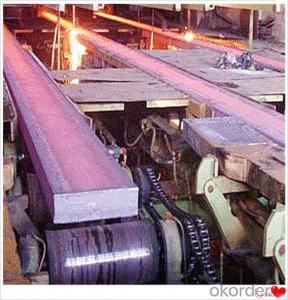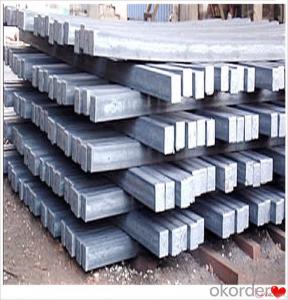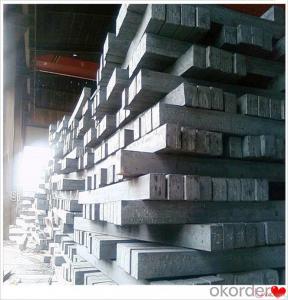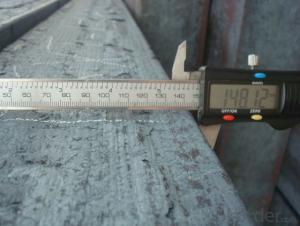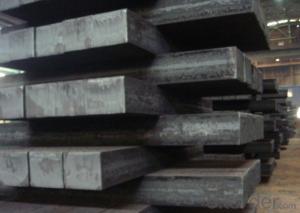5p/Ps Steel Billets Q235,Q255,Q275,Q345,3SP,5SP,20MnSi
- Loading Port:
- China main port
- Payment Terms:
- TT OR LC
- Min Order Qty:
- 20 m.t.
- Supply Capability:
- 200000 m.t./month
OKorder Service Pledge
OKorder Financial Service
You Might Also Like
5p/Ps Steel Billets Q235,Q255,Q275,Q345,3SP,5SP,20MnSi
Specification
Steel billet(ingot) by cogging or breakdown of semi-finished products, is the raw material of all kinds of steel mill. Billet section of square, round, flat, rectangular and abnormity of several kinds of, mainly related to the shape of rolled products.
CNBM Q235,Q275,Q345,3SP,5SP,20MnSi Billets Steel
Hot Rolled Steel Billets/ Mild Steel Bar/ Billet Steel
Specification (see below)
Standard: GB/JIS/ASTM
Size: 50*50mm-180*180mm
Length: 3-12mtrs or Customised
Steel material: Q235,Q255,Q275,Q345,3SP,5SP,20MnSi
Technique: Hot rolled
FOB Unit Ton Price $250-350 and Usually I will quote you CFR price.
MOQ: Usually 1000-10000MT/size
Shipment:By Container,Bulk Vessel
Packaging Details: bundles with steel strips or as customers's requirements
Delivery time: Usually within 30 days after the deposit/LC
Inspection:Third party inspection before loading.
Technical data
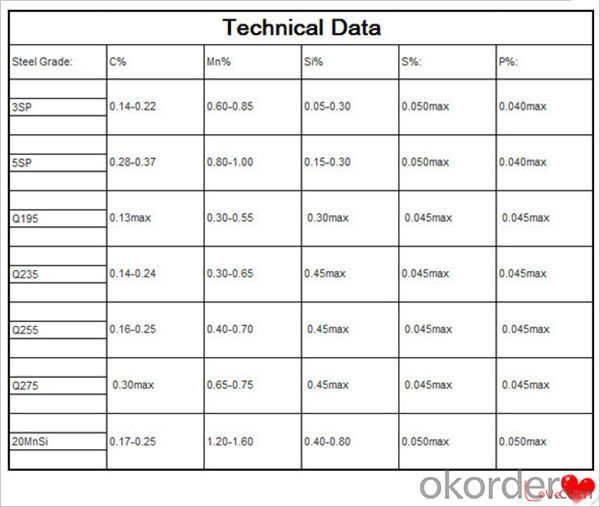
Feature Steel Billet
Rectangular billet continuous casting billet and mainly general carbon steel, low carbon low silicon cold-rolled material, high quality carbon structural steel, high strength low alloy steel, special steel, etc.
The billet is mainly divided into two kinds from the shape:
Slab: cross section width and height of the ratio of the larger, mainly used for rolling plate.
Billet: equal cross section width and height, or a huge difference, mainly used for rolling steel, wire rod. ,
Steel billets have distinct characteristics as compared with already furnished steel bars and products. Billets have a specific grain structure, which enables the metal to be processed more intricately. Steel billets are also known for their malleability and ductility, especially when exposed to varying temperatures during shaping and molding.
Packaging & Shipping
1. Packaging:
1) Small size: in bundles
2)Big size: in bulk
3)in plastic packing or as per customer requirement
2. Delivery time:
1) Normal size: within 7days send from warehouse directly
2) Special size: with 25-30days customer made for you
3. Trade terms:FOB/CFR/CIF
4. Shippment:
1) length:≤5.8m loaded in 20FT Container with 25-27tons
2) length:≤11.8m loaded in 40FT Container with 25-27tons
3) lengnth:≥12m shipped by bulk vessel, FILO terms
Steel Billet Images
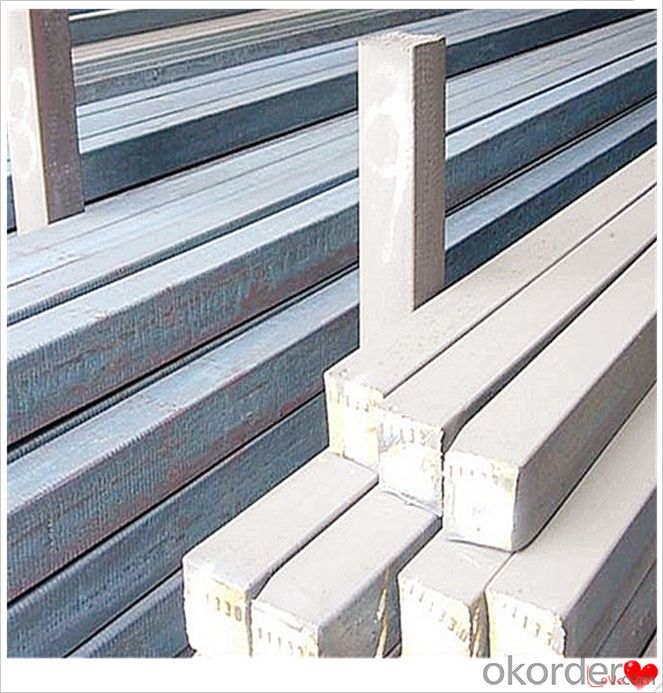
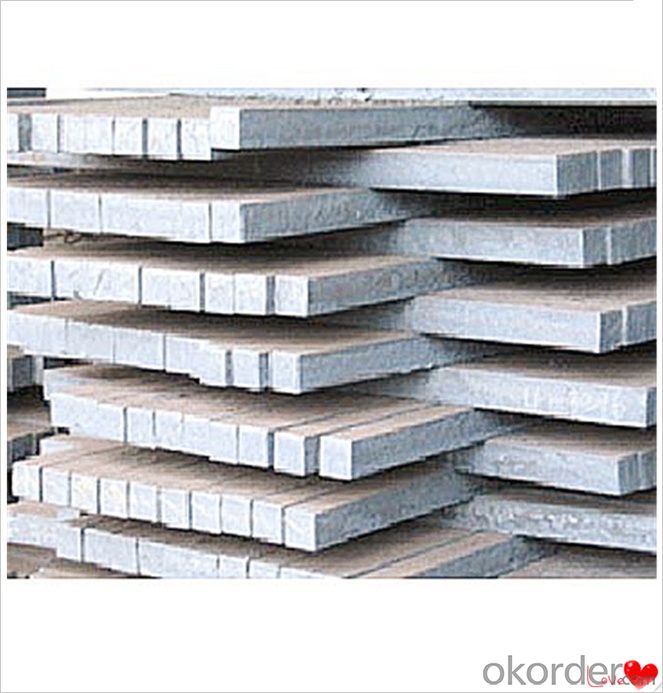
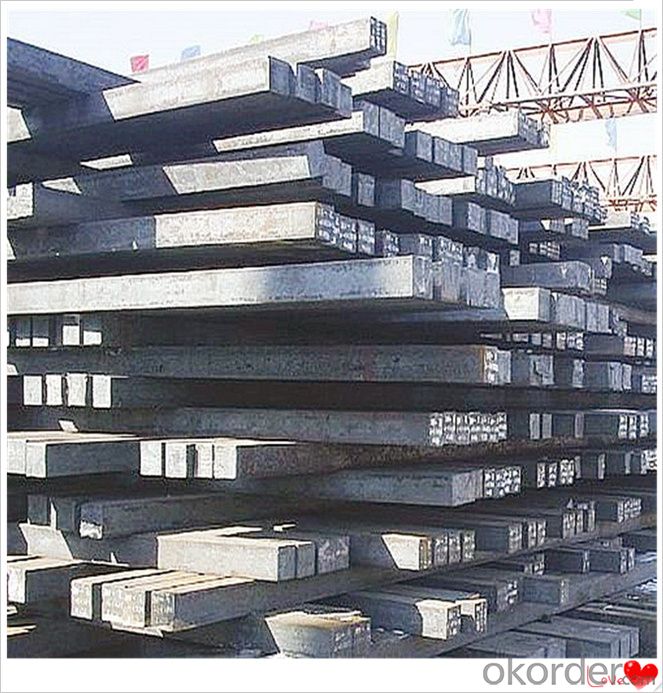

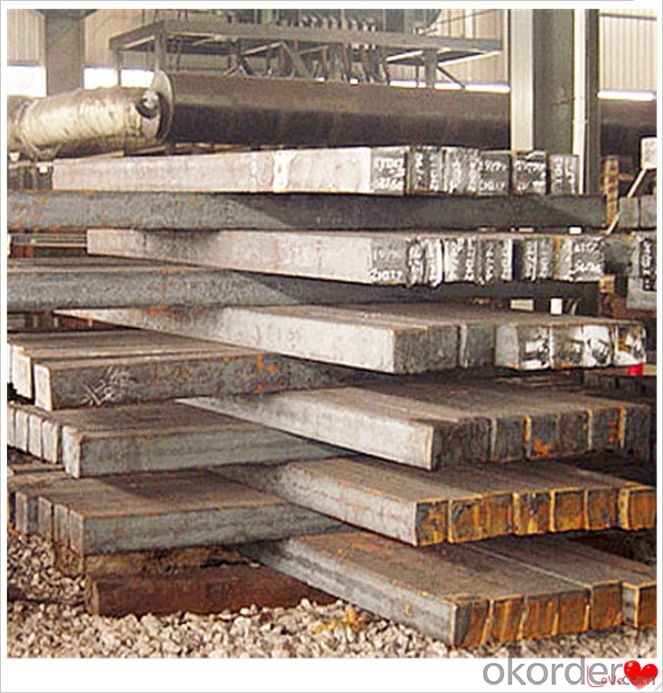
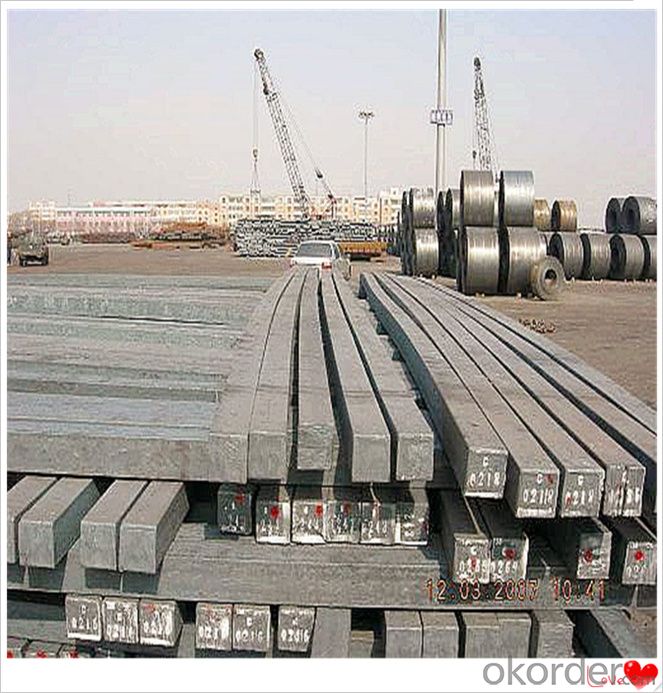
Processing
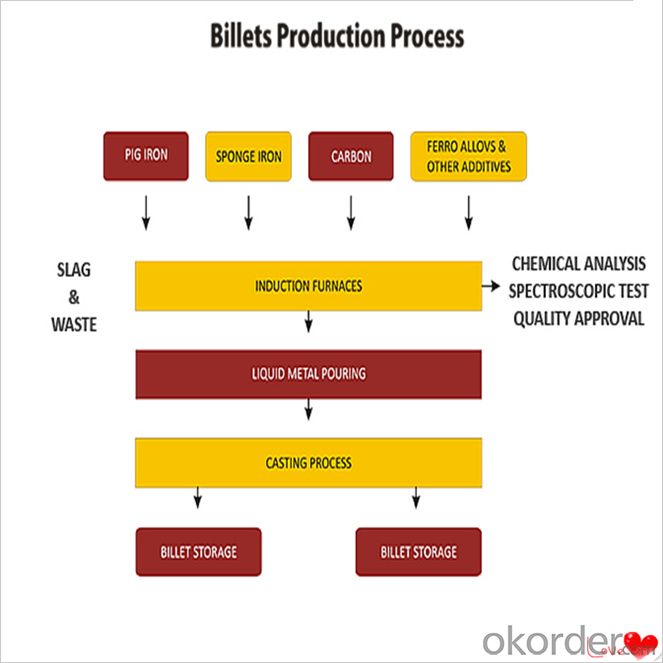
Usage-Billet Steel
Used for the plant, the bridge,shipment building high-rise building construction,lifting and transportation machinery, equipment manufracturing base building the support foundation pile manufacturing.
Billets, or ingots (as they sometimes referred to), are not of practical use until they have been formed into more functional shapes and sizes. While they have already been put in the furnace, they still require a series of shaping and molding procedures such as hot and cold working, milling and cutting before they are sold in hardware stores, or used for different applications. The unformed billets, however, can be used in striking currency such as coins and as reserves, similar to gold bars.
FAQ-Billet Steel
We have organized several common questions for our clients,may help you sincerely:
1) How about your company?
A world class manufacturer & supplier of castings forging in carbon steel and alloy steel,is one of the large-scale professional investment casting production bases in China,consisting of both casting foundry forging and machining factory. Annually more than 8000 tons Precision casting and forging parts are exported to markets in Europe,America and Japan. OEM casting and forging service available according to customer’s requirements.
2) How to guarantee the quality of the products?
We have established the international advanced quality management system,every link from raw material to final product we have strict quality test;We resolutely put an end to unqualified products flowing into the market. At the same time, we will provide necessary follow-up service assurance.
3) How long can we receive the product after purchase?
In the purchase of product within three working days, We will arrange the factory delivery as soon as possible. The pecific time of receiving is related to the state and position of customers.Commonly 7 to 10 working days can be served.
4)Do you have your own QC department?
Yes, we have, our QC department will inspect the goods during the process of mass production and after completion of production.
hot sale!!! Cast Steel Grades/ mild steel bar/ billet steel
(1): High quality steel with reasonable price.
(2): Wide excellent experiences with after-sale service.
(3): Every process will be checked by responsible QC which insures every product's quality.
(4): Professional packing teams which keep every packing safely.
(5): Trial order can be done in one week.
(6): Samples can be provided as your requirements.
- Q: How are steel billets used in the manufacturing of telecommunications equipment?
- Steel billets are used in the manufacturing of telecommunications equipment as they serve as raw material for various components such as brackets, frames, and enclosures. These billets are shaped and machined into precise forms to provide structural support and protection for sensitive electronic components within telecommunications devices. Additionally, steel billets may also be used in the production of antenna towers and infrastructure, ensuring stability and durability in the telecommunications industry.
- Q: How are steel billets used in the production of aerospace structures?
- Steel billets are used in the production of aerospace structures as they are melted and cast into various shapes to create critical components such as beams, brackets, and fittings. These billets serve as the raw material that undergoes further processing, including machining, welding, and heat treatment, to meet the specific requirements and tolerances of aerospace applications. The high strength and durability of steel make it an ideal material for aerospace structures, ensuring the safety and reliability of aircraft.
- Q: How do steel billets contribute to the manufacturing of construction materials?
- The utilization of steel billets is crucial in the manufacturing of construction materials, playing a vital role in the industry. These billets serve as the primary raw material that undergoes transformation into a diverse range of steel products, which are then utilized in construction projects. To begin with, steel billets act as the starting point for the production of different types of steel products, including bars, rods, beams, and sections. These products are of utmost importance in the construction sector, as they provide structural support and reinforcement. For instance, steel bars are commonly employed in the construction of reinforced concrete structures, thereby imparting strength and durability to the building. Moreover, steel billets find application in the production of pipes and tubes, which hold great significance in plumbing, heating, ventilation, and air conditioning (HVAC) systems within buildings. These pipes and tubes ensure the efficient flow of water, gas, and air, thereby contributing to the overall functionality and comfort of the structure. Furthermore, steel billets are utilized in the manufacturing of steel sheets and plates, which are extensively used in construction applications such as roofing, cladding, and flooring. These steel sheets and plates offer exceptional strength, resistance to corrosion, and aesthetic appeal. They are commonly employed in high-rise buildings, warehouses, and industrial facilities. Additionally, steel billets play a crucial role in the production of prefabricated construction materials. Prefabrication involves the manufacturing of building components off-site, which are subsequently transported and assembled on-site. Steel billets are employed in the creation of prefabricated steel frames, trusses, and panels, streamlining the construction process and reducing time and labor costs. In conclusion, steel billets serve as the foundation of the construction materials industry. Their transformation into various steel products is imperative for structural support, reinforcement, plumbing, HVAC systems, roofing, cladding, flooring, and prefabrication. The utilization of steel billets ensures the strength, durability, and functionality of construction materials, making a significant contribution to the overall quality of construction projects.
- Q: What are the different methods of steel billet surface cleaning?
- There are several methods of steel billet surface cleaning, including shot blasting, pickling, acid cleaning, mechanical cleaning, and electrochemical cleaning.
- Q: What is the role of steel billets in the production of wire rods?
- Steel billets are a crucial raw material in the production of wire rods. They serve as the starting point for the wire rod manufacturing process. The billets are heated and then passed through a series of rolling mills to reduce their thickness and shape them into wire rods. This process helps to improve the mechanical properties and surface quality of the wire rods. Therefore, steel billets play a significant role in ensuring the quality and strength of wire rods used in various industries such as construction, automotive, and manufacturing.
- Q: Are steel billets used in the production of electrical transmission towers?
- The utilization of steel billets is widespread in the manufacturing of electrical transmission towers. At the onset of the production process, steel billets serve as the primary form of steel. They are typically shaped and sized through hot rolling, resulting in various sections and components required for constructing transmission towers. Due to its remarkable strength and durability, steel emerges as the perfect material for such structures, which must endure harsh environmental conditions and uphold heavy electrical conductors. Additionally, steel possesses exceptional electrical conductivity properties, a vital characteristic for ensuring the efficient transmission of electricity through the towers. In summary, steel billets assume a pivotal role in the creation of electrical transmission towers, guaranteeing their strength, durability, and efficiency.
- Q: What are the potential applications of steel billets in the food and beverage aftermarket?
- Steel billets offer a wide array of possibilities in the food and beverage aftermarket. One possibility is their use in fabricating food processing equipment. Machinery and tools like conveyor belts, food mixers, and cutting implements can all be produced with steel billets. The strength and durability of steel make it an ideal material for these applications, as it can withstand heavy use and maintain its integrity even in harsh conditions. Another application for steel billets in the food and beverage aftermarket is the construction of storage tanks and containers. Steel's corrosion resistance makes it perfect for storing a variety of food and beverage products. Tanks and containers manufactured with steel billets can securely hold liquids such as water, juices, and alcoholic beverages. These tanks can also be insulated to ensure proper temperature control, which is crucial for preserving the quality of perishable items. In addition, steel billets can be used to produce kitchen equipment and utensils. Steel is a hygienic material that is easy to clean and maintain, making it well-suited for use in commercial kitchens and food preparation areas. Knives, pans, and cooking pots are just a few examples of kitchen utensils that can be shaped from steel billets. These utensils are known for their durability and ability to conduct heat evenly, resulting in efficient food preparation and cooking. Overall, the potential applications of steel billets in the food and beverage aftermarket are extensive. Whether it's food processing equipment, storage tanks, or kitchen utensils, steel billets provide a dependable and versatile material for various industries within the food and beverage sector. Its strength, durability, and hygienic properties make it a valuable resource for ensuring the safe and efficient production, storage, and preparation of food and beverages.
- Q: How are steel billets inspected for dimensional accuracy?
- Steel billets are inspected for dimensional accuracy through a series of rigorous processes to ensure that they meet the required specifications. These inspections are crucial as any deviations in the dimensions can have a significant impact on the final product's quality and performance. Firstly, steel billets are visually inspected to identify any surface defects or irregularities. This includes checking for cracks, surface oxidation, or any other visible abnormalities that could affect the dimensions. This visual inspection is often conducted by trained personnel who have an eye for detail and can identify even the smallest imperfections. After the visual inspection, the billets undergo dimensional measurement using various tools and instruments. One commonly used tool is a caliper, which is used to measure the length, width, and height of the billet. The measurements are compared against the specified dimensions to ensure they fall within the acceptable range. Any deviations beyond the tolerance limit are flagged for further investigation. In addition to calipers, other tools such as micrometers, height gauges, and coordinate measuring machines (CMM) may also be used to measure specific dimensions or features of the billet. These instruments provide more accurate and precise measurements, especially for critical dimensions that require a higher level of precision. Furthermore, non-destructive testing techniques are employed to assess the internal quality and dimensional accuracy of the billets. Ultrasonic testing, for instance, uses high-frequency sound waves to detect any internal defects or inconsistencies that may affect the dimensions. This method can identify hidden flaws such as voids, inclusions, or discontinuities, providing a comprehensive assessment of the billet's dimensional accuracy. Overall, steel billets are inspected for dimensional accuracy through a combination of visual inspections, dimensional measurements using various tools, and non-destructive testing techniques. By conducting these inspections, manufacturers ensure that the billets meet the required specifications, leading to high-quality final products.
- Q: How do steel billets contribute to the overall safety of a product?
- Steel billets contribute to the overall safety of a product by providing a strong and durable foundation. They are used as raw material in the manufacturing of various products, including construction materials, automotive parts, and machinery. The high strength and structural integrity of steel billets ensure that the end products are able to withstand heavy loads, extreme conditions, and potential hazards, thus enhancing safety and reliability.
- Q: How are steel billets used in the shipbuilding industry?
- The shipbuilding industry relies heavily on steel billets, which are vital for constructing different parts and structures of ships. These billets serve as the raw material for making essential components like hulls, frames, bulkheads, and other structural elements. To meet the requirements of shipbuilding, steel must possess exceptional strength, durability, and resistance to corrosion. Steel billets are an ideal choice because of their high-quality composition and properties. Initially, these billets are shaped and formed into specific dimensions, depending on the ship's design needs. Once the steel billets are ready, they are used in various shipbuilding processes. One of their key applications is in building the ship's hull, which provides the necessary strength and buoyancy. Steel billets are cut and welded together to create the framework of the hull, ensuring the ship's structural integrity and stability. Additionally, steel billets are used in manufacturing frames, bulkheads, and decks. Frames offer structural support and rigidity to the ship's framework, while bulkheads divide the internal space into separate compartments, enhancing safety and preventing water ingress in case of damage. Decks, on the other hand, serve as the ship's floors on different levels. Furthermore, steel billets are utilized for fabricating various equipment and machinery installed on ships. These include propulsion systems, cranes, winches, and other heavy-duty components that contribute to the ship's functionality and operational capabilities. Overall, steel billets play a crucial role in the shipbuilding industry as they form the foundation for constructing ships and their essential components. Their high-quality steel and versatility enable shipbuilders to create vessels that meet stringent safety standards, withstand harsh marine conditions, and ensure long service life.
Send your message to us
5p/Ps Steel Billets Q235,Q255,Q275,Q345,3SP,5SP,20MnSi
- Loading Port:
- China main port
- Payment Terms:
- TT OR LC
- Min Order Qty:
- 20 m.t.
- Supply Capability:
- 200000 m.t./month
OKorder Service Pledge
OKorder Financial Service
Similar products
Hot products
Hot Searches
Related keywords
